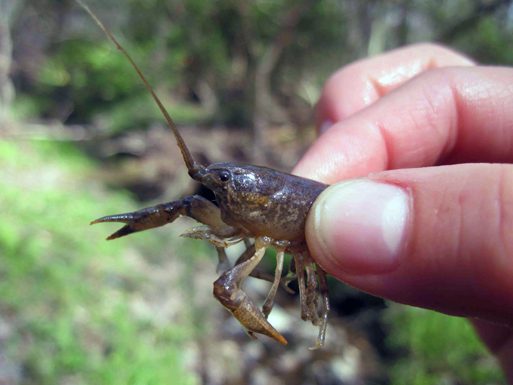You get a line, I’ll get a pole, we’ll go fishing in a crawdad hole

What better summertime activity for a kid in the country than playing in a creek? There is really nothing better than sticking your feet in a cool stream under the forest canopy where it feels 10 degrees cooler than in the sun. And whenever I walk in the woods and come up to a rocky branch, I’m sure to stop and flip a few rocks to see what might be hiding underneath.
You may find salamanders, mayfly or dragonfly larvae squirming and twisting in the flowing water. But if you wait patiently until the silt settles you just may see a cautious crustacean with pinchers waving, ready to defend its rocky abode.
Crayfish, also known as crawfish or crawdads, are a small common freshwater crustacean in the families Astacidae and Parastacidae. Although most active at night, many can be found in daytime under rocks and logs in streams. They breathe through gills and feed on aquatic plant and animal matter.
There are approximately 500 species of crayfish, found in both northern and southern hemispheres. But the greatest diversity of crayfish is in the southeastern United States, with more than 330 species. There are more than 40 species in North Carolina, found across the state in the mountains, Piedmont and coastal plain.
 Crayfish have three main parts – a head, thorax and abdomen – and possess a thick exoskeleton and large claws or pinchers for protection. They look like tiny lobsters but are smaller and, unlike lobsters, crayfish live in freshwater – in lakes, streams, ponds, and in marshes in the coastal plain. They have a large variation in color. They may be red, blue, brown, tan or green. They have a strong tail that propels them backwards, and if they lose a claw or leg a new one grows in its place. Young crayfish molt several times during the first few months, as they outgrow their shell.
Crayfish have three main parts – a head, thorax and abdomen – and possess a thick exoskeleton and large claws or pinchers for protection. They look like tiny lobsters but are smaller and, unlike lobsters, crayfish live in freshwater – in lakes, streams, ponds, and in marshes in the coastal plain. They have a large variation in color. They may be red, blue, brown, tan or green. They have a strong tail that propels them backwards, and if they lose a claw or leg a new one grows in its place. Young crayfish molt several times during the first few months, as they outgrow their shell.
They thrive in clear and clean water. Since many species can’t tolerate pollution, finding them in streams is a sign of good water quality.
Crayfish are often used as bait for fishing, which has sometimes resulted in inadvertent introductions of non-native crayfish to our state. In some cases these non-natives become invasive and eliminate the native crayfish. For that reason, it is important not to release live crayfish into water when fishing.
One special species endemic to the N.C. Piedmont, which means it is found in our region and nowhere else, is the Greensboro burrowing crayfish (Cambarus catagius). This species was originally known from just one neighborhood in Greensboro. It is a small crayfish about 2 inches long, and can be brown, tan and green. They are considered “primary burrowers,” which means they spend almost all their life in the burrows and are rarely found in open water. Some burrowing crayfish construct chimneys, or piles of burrowing matter near the opening. Greensboro burrowing crayfish do not create chimneys, but just pile the material near the entrance hole, which is usually around 2 inches in diameter.
Greensboro burrowing crayfish are known only from the upper Piedmont in the Yadkin-Pee Dee and Cape Fear river basins. They occur in areas from Greensboro to the Uwharries, in Guilford, Randolph, Davidson and Montgomery counties. They are typically found in sandy-clay soils. The species is not listed as rare or threatened because there is not enough data to really know how the species is doing, but it is a candidate being considered for listing because of the limited range and reduction of habitat.
This is another interesting species unique to our region that we know little about. It serves as a reminder of how biologically diverse North Carolina is.